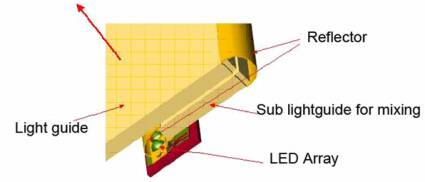A Revolution? The First Lumileds LCD Display
The Promise Of Lumileds
In contrast, LED backlighting technology is quite different. On the SpectraView 2180WG-LED, the fluorescent tubes have been replaced by an array of 48 LEDs in adjustable colors. That may seem hardly worthy of note, but the performance of the LCD panel used in the 2180UX we tested not long ago has been boosted impressively.
Document source: NEC
As you can see in this diagram, the brightness of the LED is dispersed by a light guide and bounced by the reflector to provide uniform brightness.
Another advantage is that the onboard software is in total control of the color of the backlighting; this means that it's no longer necessary to compensate for the shortcomings of the lamps. The color can be anticipated, resulting in a perfect white never attained by traditional backlighting. Thanks to a built-in sensor and appropriate circuitry, the SpectraView 2180WG can change the color of the backlighting dynamically as a function of the color temperature that the user wants. This means that the colors are richer and the color gamut extends far beyond what other LCDs can provide.
Finally, the longevity of modern LEDs has long been proven. By adjusting the number and density of the LEDs, high brightness values can be achieved without significantly diminishing the life expectancy of TV sets.
Now we know what Lumileds are capable of. But there's nothing like real-life trials and Tom's Hardware methodology to see what the performance is really like.
Get Tom's Hardware's best news and in-depth reviews, straight to your inbox.
Current page: The Promise Of Lumileds
Prev Page What Traditional LCD Offers Next Page NEC SpectraView 2180WG-LED: Superlatives